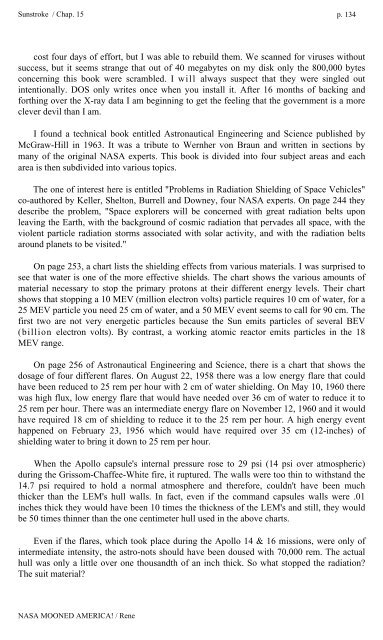Rene-NASA-Mooned-America
Rene-NASA-Mooned-America
Rene-NASA-Mooned-America
Create successful ePaper yourself
Turn your PDF publications into a flip-book with our unique Google optimized e-Paper software.
Sunstroke / Chap. 15 p. 134<br />
cost four days of effort, but I was able to rebuild them. We scanned for viruses without<br />
success, but it seems strange that out of 40 megabytes on my disk only the 800,000 bytes<br />
concerning this book were scrambled. I will always suspect that they were singled out<br />
intentionally. DOS only writes once when you install it. After 16 months of backing and<br />
forthing over the X-ray data I am beginning to get the feeling that the government is a more<br />
clever devil than I am.<br />
I found a technical book entitled Astronautical Engineering and Science published by<br />
McGraw-Hill in 1963. It was a tribute to Wernher von Braun and written in sections by<br />
many of the original <strong>NASA</strong> experts. This book is divided into four subject areas and each<br />
area is then subdivided into various topics.<br />
The one of interest here is entitled "Problems in Radiation Shielding of Space Vehicles"<br />
co-authored by Keller, Shelton, Burrell and Downey, four <strong>NASA</strong> experts. On page 244 they<br />
describe the problem, "Space explorers will be concerned with great radiation belts upon<br />
leaving the Earth, with the background of cosmic radiation that pervades all space, with the<br />
violent particle radiation storms associated with solar activity, and with the radiation belts<br />
around planets to be visited."<br />
On page 253, a chart lists the shielding effects from various materials. I was surprised to<br />
see that water is one of the more effective shields. The chart shows the various amounts of<br />
material necessary to stop the primary protons at their different energy levels. Their chart<br />
shows that stopping a 10 MEV (million electron volts) particle requires 10 cm of water, for a<br />
25 MEV particle you need 25 cm of water, and a 50 MEV event seems to call for 90 cm. The<br />
first two are not very energetic particles because the Sun emits particles of several BEV<br />
(billion electron volts). By contrast, a working atomic reactor emits particles in the 18<br />
MEV range.<br />
On page 256 of Astronautical Engineering and Science, there is a chart that shows the<br />
dosage of four different flares. On August 22, 1958 there was a low energy flare that could<br />
have been reduced to 25 rem per hour with 2 cm of water shielding. On May 10, 1960 there<br />
was high flux, low energy flare that would have needed over 36 cm of water to reduce it to<br />
25 rem per hour. There was an intermediate energy flare on November 12, 1960 and it would<br />
have required 18 cm of shielding to reduce it to the 25 rem per hour. A high energy event<br />
happened on February 23, 1956 which would have required over 35 cm (12-inches) of<br />
shielding water to bring it down to 25 rem per hour.<br />
When the Apollo capsule's internal pressure rose to 29 psi (14 psi over atmospheric)<br />
during the Grissom-Chaffee-White fire, it ruptured. The walls were too thin to withstand the<br />
14.7 psi required to hold a normal atmosphere and therefore, couldn't have been much<br />
thicker than the LEM's hull walls. In fact, even if the command capsules walls were .01<br />
inches thick they would have been 10 times the thickness of the LEM's and still, they would<br />
be 50 times thinner than the one centimeter hull used in the above charts.<br />
Even if the flares, which took place during the Apollo 14 & 16 missions, were only of<br />
intermediate intensity, the astro-nots should have been doused with 70,000 rem. The actual<br />
hull was only a little over one thousandth of an inch thick. So what stopped the radiation<br />
The suit material<br />
<strong>NASA</strong> MOONED AMERICA! / <strong>Rene</strong>


